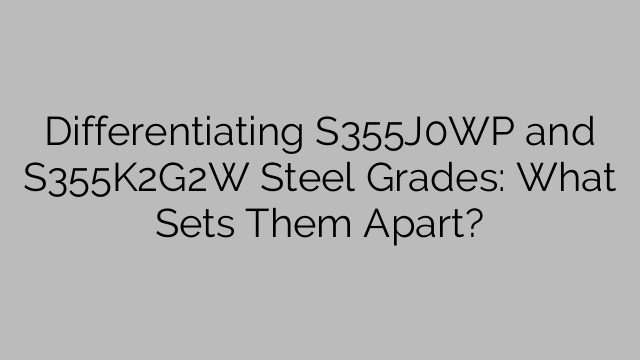Differentiating S355J0WP and S355K2G2W Steel Grades: What Sets Them Apart?
Steel has become one of the most widely used materials in the construction industry due to its strength, durability, and flexibility. Various steel grades cater to different applications depending on the environmental conditions and the required mechanical properties. Two such grades are S355J0WP and S355K2G2W, which are often compared due to their similar compositions but with a few key differences. Let’s delve into what sets them apart and why these differences matter.
Both S355J0WP and S355K2G2W are weathering steel grades, also known as Corten steel, which possess corrosion-resistant properties. They are primarily used in outdoor structures, such as bridges, buildings, and facades, where exposure to the elements is a constant challenge. These steel grades are specifically designed to form a protective oxide layer on their surfaces, which prevents further corrosion and eliminates the need for additional surface treatments.
The key distinction between the two grades lies in their chemical compositions. S355J0WP contains higher levels of phosphorus, copper, chromium, and nickel compared to S355K2G2W. These additional elements enhance the steel’s corrosion resistance and improve its ability to withstand harsh weather conditions, such as heavy rainfall, humidity, and saltwater exposure. Moreover, the increased presence of phosphorus aids in the formation of the protective oxide layer, further safeguarding the steel from corrosion.
Another important aspect to consider is the mechanical properties of the two grades. S355J0WP has a minimum yield strength of 355 MPa, while S355K2G2W offers a higher minimum yield strength of 460 MPa. This means that S355K2G2W possesses superior strength, making it suitable for applications that require increased structural integrity or load-bearing capacities. However, it is important to note that the tensile strength and elongation properties of both grades are similar, ensuring they can withstand external forces without compromising their structural integrity.
When it comes to applications, S355J0WP is generally recommended for non-demanding structures in moderate corrosive environments, where aesthetics play a significant role. Its decorative appearance, which develops a characteristic patina over time, is highly coveted and ensures a visually appealing finish. On the other hand, S355K2G2W’s higher strength makes it suitable for more demanding applications, such as heavy-duty structural components or those exposed to extreme weather conditions.
In terms of availability and cost, both grades are readily available in the market, thanks to their popularity and wide usage. However, S355J0WP tends to be slightly more affordable due to its lower alloy content in comparison to S355K2G2W. Thus, the choice between the two grades depends on the specific requirements of the project, including the desired level of corrosion resistance, strength, and cost considerations.
In conclusion, while S355J0WP and S355K2G2W share weathering steel properties and are commonly used in outdoor structures, their differences lie in their chemical compositions, mechanical properties, and suitability for various applications. S355J0WP with its enhanced corrosion resistance and aesthetic appeal is best suited for non-demanding structures, whereas S355K2G2W’s higher strength makes it ideal for more demanding applications. Understanding these nuances helps engineers and architects make informed decisions when selecting the right steel grade for their projects.

